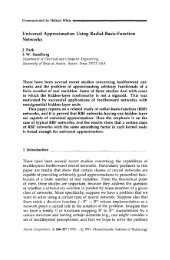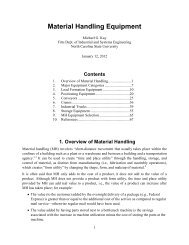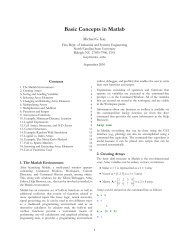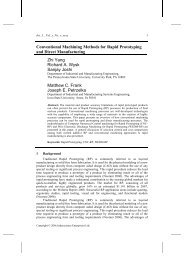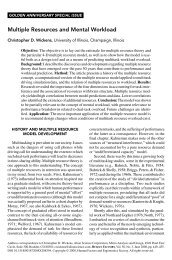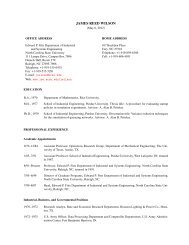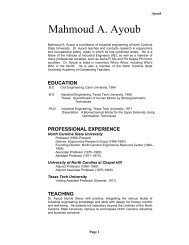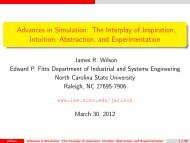Situation Awareness: Review of Mica Endsley's 1995 Articles on ...
Situation Awareness: Review of Mica Endsley's 1995 Articles on ...
Situation Awareness: Review of Mica Endsley's 1995 Articles on ...
You also want an ePaper? Increase the reach of your titles
YUMPU automatically turns print PDFs into web optimized ePapers that Google loves.
402 June 2008 – Human Factors<br />
keep this debate healthily alive (Parasuraman,<br />
Sheridan, & Wickens, 2008, in press).<br />
CONCLUSION<br />
The c<strong>on</strong>cept <str<strong>on</strong>g>of</str<strong>on</strong>g> situati<strong>on</strong> awareness lies at the<br />
heart <str<strong>on</strong>g>of</str<strong>on</strong>g> the intersecti<strong>on</strong> between basic cognitive<br />
psychology and the applied science <str<strong>on</strong>g>of</str<strong>on</strong>g> human<br />
factors. The two articles reviewed here, as well as<br />
the vast amount <str<strong>on</strong>g>of</str<strong>on</strong>g> Endsley’s other research, represent<br />
a critical c<strong>on</strong>tributi<strong>on</strong> within which a growing<br />
body <str<strong>on</strong>g>of</str<strong>on</strong>g> research was integrated and served to<br />
stimulate a productive and useful corpus <str<strong>on</strong>g>of</str<strong>on</strong>g> human<br />
factors c<strong>on</strong>clusi<strong>on</strong>s and further research. As automati<strong>on</strong><br />
c<strong>on</strong>tinues to be imposed in human work<br />
envir<strong>on</strong>ments, there is little doubt that the interest<br />
in how SA may degrade or be supported will<br />
c<strong>on</strong>tinue to grow.<br />
REFERENCES<br />
Adams, M., Tenney, Y., & Pew, R. W. (<str<strong>on</strong>g>1995</str<strong>on</strong>g>). <str<strong>on</strong>g>Situati<strong>on</strong></str<strong>on</strong>g> awareness and<br />
the cognitive management <str<strong>on</strong>g>of</str<strong>on</strong>g> complex systems. Human Factors,<br />
37, 85–104.<br />
Alexander, A. L., & Wickens, C. D. (2005). Synthetic visi<strong>on</strong> systems:<br />
Flightpath tracking, situati<strong>on</strong> awareness and visual scanning in an<br />
integrated hazard display. In R. Jensen (Ed.), Proceedings <str<strong>on</strong>g>of</str<strong>on</strong>g> the<br />
13th Internati<strong>on</strong>al Symposium <strong>on</strong> Aviati<strong>on</strong> Psychology (CD-ROM).<br />
Oklahoma City, OK: Federal Aviati<strong>on</strong> Administrati<strong>on</strong>. Retrieved<br />
March 7, 2008, from http://www.humanfactors.uiuc.edu/Reports&<br />
PapersPDFs/isap05/alexwicavpsy05.pdf<br />
Banbury, S., & Tremblay, S. (Eds.) (2004). A cognitive approach to situati<strong>on</strong><br />
awareness: Theory, measurement and applicati<strong>on</strong>. Aldershot,<br />
UK: Ashgate Publishing.<br />
Cooke, N. J., & Gorman, J. C. (2006). Assessment <str<strong>on</strong>g>of</str<strong>on</strong>g> team cogniti<strong>on</strong>. In<br />
W. Karwowski (Ed.), Internati<strong>on</strong>al encyclopedia <str<strong>on</strong>g>of</str<strong>on</strong>g> erg<strong>on</strong>omics and<br />
human factors (2nd ed., pp. 270–275). L<strong>on</strong>d<strong>on</strong>: Taylor & Francis.<br />
Cooke, N. J., Gorman, G. C., & Winner, J. L. (2007). Team cogniti<strong>on</strong>. In<br />
F. Durso, R. Nickers<strong>on</strong>, S. Dumais, S. Lewandowsky, & T. Perfect<br />
(Eds.), Handbook <str<strong>on</strong>g>of</str<strong>on</strong>g> applied cogniti<strong>on</strong> (2nd ed., pp. 239–268).<br />
Hoboken, NJ: Wiley.<br />
Dekker, S., & Hollnagel, E. (2004). Human factors and folk models.<br />
Cogniti<strong>on</strong>, Technology, and Work, 6, 79–86.<br />
Dekker, S. W. A., & Woods, D. D. (2002). MABA-MABA or abracadabra<br />
Progress <strong>on</strong> human-automati<strong>on</strong> coordinati<strong>on</strong>. Cogniti<strong>on</strong>,<br />
Technology, and Work, 4, 240–244.<br />
Durso, F., Bleckley, M. K., & Dattel, A. (2007). Does situati<strong>on</strong> awareness<br />
add to the validity <str<strong>on</strong>g>of</str<strong>on</strong>g> cognitive tests Human Factors, 48,<br />
721–733.<br />
Durso, F., & Gr<strong>on</strong>lund, S. D. (1999). <str<strong>on</strong>g>Situati<strong>on</strong></str<strong>on</strong>g> awareness. In F. T. Durso,<br />
R. Nickers<strong>on</strong>, R. Schvaneveldt, S. Dumais, M. Chi, & S. Lindsay<br />
(Eds.), Handbook <str<strong>on</strong>g>of</str<strong>on</strong>g> applied cogniti<strong>on</strong> (pp. 283–314). New York:<br />
Wiley.<br />
Durso, F., Raws<strong>on</strong>, K., & Girotto, S. (2007). Comprehensi<strong>on</strong> and<br />
situati<strong>on</strong> awareness. In F. Durso, R. Nickers<strong>on</strong>, S. Dumais,<br />
S. Lewandowsky, & T. Perfect (Eds.), Handbook <str<strong>on</strong>g>of</str<strong>on</strong>g> applied cogniti<strong>on</strong><br />
(2nd ed., pp. 163–194). Hoboken, NJ: Wiley.<br />
Edwards, W. (1961). Behavioral decisi<strong>on</strong> theory. Annual <str<strong>on</strong>g>Review</str<strong>on</strong>g> <str<strong>on</strong>g>of</str<strong>on</strong>g><br />
Psychology, 12, 473–489.<br />
Endsley, M. R. (1988). Design and evaluati<strong>on</strong> for situati<strong>on</strong> awareness<br />
enhancement. In Proceedings <str<strong>on</strong>g>of</str<strong>on</strong>g> the Human Factors Society 32nd<br />
Annual Meeting (pp. 97–101). Santa M<strong>on</strong>ica, CA: Human Factors<br />
Society.<br />
Endsley, M. R. (1993). <str<strong>on</strong>g>Situati<strong>on</strong></str<strong>on</strong>g> awareness and workload: Flip sides<br />
<str<strong>on</strong>g>of</str<strong>on</strong>g> the same coin. In R. S. Jensen & D. Neumeister (Eds.), Proceedings<br />
<str<strong>on</strong>g>of</str<strong>on</strong>g> the Seventh Internati<strong>on</strong>al Symposium <strong>on</strong> Aviati<strong>on</strong> Psychology<br />
(pp. 906–911). Columbus: Department <str<strong>on</strong>g>of</str<strong>on</strong>g> Aviati<strong>on</strong>, The<br />
Ohio State University.<br />
Endsley, M. R. (<str<strong>on</strong>g>1995</str<strong>on</strong>g>a). Measurement <str<strong>on</strong>g>of</str<strong>on</strong>g> situati<strong>on</strong> awareness in dynamic<br />
systems. Human Factors, 37, 65–84.<br />
Endsley, M. R. (<str<strong>on</strong>g>1995</str<strong>on</strong>g>b). Toward a theory <str<strong>on</strong>g>of</str<strong>on</strong>g> situati<strong>on</strong> awareness in dynamic<br />
systems. Human Factors, 37, 32–64.<br />
Endsley, M. R. (2006a). Expertise and situati<strong>on</strong> awareness. In K. A.<br />
Ericss<strong>on</strong>, N. Charness, P. J. Feltovich, & R. R. H<str<strong>on</strong>g>of</str<strong>on</strong>g>fman (Eds.), The<br />
Cambridge handbook <str<strong>on</strong>g>of</str<strong>on</strong>g> expertise and expert performance (pp.<br />
633–651). New York: Cambridge University Press.<br />
Endsley, M. R. (2006b). <str<strong>on</strong>g>Situati<strong>on</strong></str<strong>on</strong>g> awareness. In G. Salvendy (Ed.),<br />
Handbook <str<strong>on</strong>g>of</str<strong>on</strong>g> human factors and erg<strong>on</strong>omics (3rd ed., pp. 528–542).<br />
New York: Wiley.<br />
Endsley, M. R., Bolte, B., & J<strong>on</strong>es, D. G. (2003). Designing for situati<strong>on</strong><br />
awareness: An approach to human-centered design. L<strong>on</strong>d<strong>on</strong>: Taylor<br />
& Francis.<br />
Endsley, M. R., & Garland, D. G. (Eds.). (2001). <str<strong>on</strong>g>Situati<strong>on</strong></str<strong>on</strong>g> awareness<br />
analysis and measurement. Atlanta, GA: CRC Press.<br />
Endsley, M. R., & J<strong>on</strong>es, W. M. (2001). A model <str<strong>on</strong>g>of</str<strong>on</strong>g> inter- and intrateam<br />
situati<strong>on</strong> awareness: Implicati<strong>on</strong>s for design, training and measurement.<br />
In M. McNeese, E. Salas, & M. Endsley (Eds.), New trends in<br />
cooperative activities: Understanding system dynamics in complex<br />
envir<strong>on</strong>ments (pp. 46–67). Santa M<strong>on</strong>ica, CA: Human Factors and<br />
Erg<strong>on</strong>omics Society.<br />
Endsley, M. R., & Kaber, D. B. (1999). Level <str<strong>on</strong>g>of</str<strong>on</strong>g> automati<strong>on</strong> effects <strong>on</strong><br />
performance, situati<strong>on</strong> awareness and workload in a dynamic c<strong>on</strong>trol<br />
task. Erg<strong>on</strong>omics, 42, 462–492.<br />
Endsley, M. R., & Kiris, E. O. (<str<strong>on</strong>g>1995</str<strong>on</strong>g>). The out-<str<strong>on</strong>g>of</str<strong>on</strong>g>-the-loop performance<br />
problem and level <str<strong>on</strong>g>of</str<strong>on</strong>g> c<strong>on</strong>trol in automati<strong>on</strong>. Human Factors, 37,<br />
381–394.<br />
Endsley, M. R., & Roberts<strong>on</strong>, M. M. (2000). Training for situati<strong>on</strong><br />
awareness in individuals and teams. In M. R. Endsley & D. J.<br />
Garland (Eds.), <str<strong>on</strong>g>Situati<strong>on</strong></str<strong>on</strong>g> awareness analysis and measurement<br />
(pp. 349–366). Mahwah, NJ: Erlbaum. Retrieved March 7, 2008, from<br />
http://www.satechnologies.com/Papers/pdf/SATrainingchapter.pdf<br />
Ericss<strong>on</strong>, A., & Kintch, W. (<str<strong>on</strong>g>1995</str<strong>on</strong>g>). L<strong>on</strong>g term working memory. Psychological<br />
<str<strong>on</strong>g>Review</str<strong>on</strong>g>, 102, 211–245.<br />
Fracker, M. L. (1988). A theory <str<strong>on</strong>g>of</str<strong>on</strong>g> situati<strong>on</strong> assessment: Implicati<strong>on</strong>s for<br />
measuring situati<strong>on</strong> awareness. In Proceedings <str<strong>on</strong>g>of</str<strong>on</strong>g> the Human<br />
Factors Society 32nd Annual Meeting (pp. 102–106). Santa M<strong>on</strong>ica,<br />
CA: Human Factors Society.<br />
Garg, A. X., Adhikari, N. K. J., McD<strong>on</strong>ald, H., Rosas-Arellano, M. P.,<br />
Devereaux, P. J., Bevene, J., et al. (2005). Effects <str<strong>on</strong>g>of</str<strong>on</strong>g> computerized<br />
clinical decisi<strong>on</strong> support systems <strong>on</strong> practiti<strong>on</strong>er performance and<br />
patient outcomes: A systematic review. Journal <str<strong>on</strong>g>of</str<strong>on</strong>g> the American<br />
Medical Associati<strong>on</strong>, 293, 1223–1238.<br />
Garland, D. J., & Endsley, M. R. (<str<strong>on</strong>g>1995</str<strong>on</strong>g>). Experimental analysis and<br />
measurement <str<strong>on</strong>g>of</str<strong>on</strong>g> situati<strong>on</strong> awareness. Dayt<strong>on</strong>a Beach, FL: Embry-<br />
Riddle: Aer<strong>on</strong>autical University Press.<br />
Gawr<strong>on</strong>, V. J. (2008). Human performance, workload and situati<strong>on</strong><br />
awareness measures handbook, 2nd ed. Boca Rat<strong>on</strong>, FL: CRC Press.<br />
Gentner, D., & Stevens, A. L. (1983). Mental models. Hillsdale, NJ:<br />
Erlbaum.<br />
Gopher, D. (1992). The skill <str<strong>on</strong>g>of</str<strong>on</strong>g> attenti<strong>on</strong> c<strong>on</strong>trol: Acquisiti<strong>on</strong> and executi<strong>on</strong><br />
<str<strong>on</strong>g>of</str<strong>on</strong>g> attenti<strong>on</strong> strategies. In S. Kornblum & D. E. Meyer (Eds.),<br />
Attenti<strong>on</strong> and performance XIV: Synergies in experimental psychology<br />
(pp. 299–322). Cambridge, MA: MIT Press.<br />
Gorman, J. C., Cooke, N. J., & Winner, J. L. (2006). Measuring team<br />
situati<strong>on</strong> awareness in decentralized command and c<strong>on</strong>trol systems.<br />
Erg<strong>on</strong>omics, 49, 1312–1325.<br />
Gugerty, L. (1998). Evidence from a partial report task <str<strong>on</strong>g>of</str<strong>on</strong>g> forgetting from<br />
dynamic spatial memory. Human Factors, 40, 498–508.<br />
H<str<strong>on</strong>g>of</str<strong>on</strong>g>fman, R. R., Crandall, B., & Shadbolt, N. (1998). Use <str<strong>on</strong>g>of</str<strong>on</strong>g> the critical<br />
decisi<strong>on</strong> method to elicit expert knowledge. Human Factors,<br />
40, 254–276.<br />
J<strong>on</strong>es, D. G., & Endsley, M. R. (1996). Sources <str<strong>on</strong>g>of</str<strong>on</strong>g> situati<strong>on</strong> awareness<br />
errors in aviati<strong>on</strong>. Aviati<strong>on</strong>, Space and Envir<strong>on</strong>mental Medicine,<br />
67, 507–512.<br />
Journal <str<strong>on</strong>g>of</str<strong>on</strong>g> Air Traffic C<strong>on</strong>trol. (2006). Multiple articles. January–March<br />
2006.<br />
Kaber, D. B., & Endsley, M. R. (1997). Out-<str<strong>on</strong>g>of</str<strong>on</strong>g>-the-loop performance<br />
problems and the use <str<strong>on</strong>g>of</str<strong>on</strong>g> intermediate levels <str<strong>on</strong>g>of</str<strong>on</strong>g> automati<strong>on</strong> for<br />
improved c<strong>on</strong>trol system functi<strong>on</strong>ing and safety. Process Safety<br />
Progress, 16, 126–131.<br />
Kaber, D. B., & Endsley, M. R. (2003). The effects <str<strong>on</strong>g>of</str<strong>on</strong>g> level <str<strong>on</strong>g>of</str<strong>on</strong>g> automati<strong>on</strong><br />
and adaptive automati<strong>on</strong> <strong>on</strong> human performance, situati<strong>on</strong>



